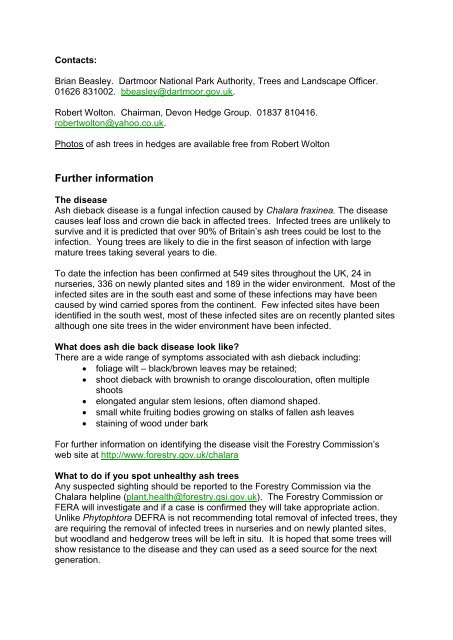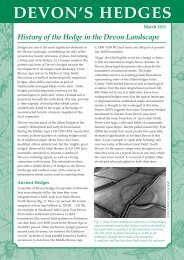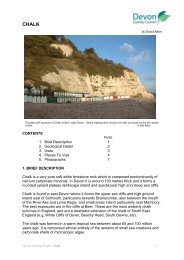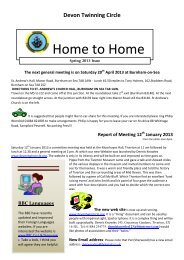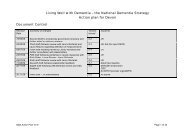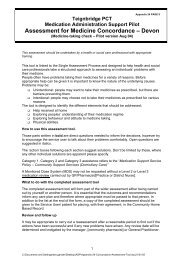Ash Dieback disease threatens Devon's hedged landscape – let's ...
Ash Dieback disease threatens Devon's hedged landscape – let's ...
Ash Dieback disease threatens Devon's hedged landscape – let's ...
Create successful ePaper yourself
Turn your PDF publications into a flip-book with our unique Google optimized e-Paper software.
Contacts:<br />
Brian Beasley. Dartmoor National Park Authority, Trees and Landscape Officer.<br />
01626 831002. bbeasley@dartmoor.gov.uk.<br />
Robert Wolton. Chairman, Devon Hedge Group. 01837 810416.<br />
robertwolton@yahoo.co.uk.<br />
Photos of ash trees in hedges are available free from Robert Wolton<br />
Further information<br />
The <strong>disease</strong><br />
<strong>Ash</strong> dieback <strong>disease</strong> is a fungal infection caused by Chalara fraxinea. The <strong>disease</strong><br />
causes leaf loss and crown die back in affected trees. Infected trees are unlikely to<br />
survive and it is predicted that over 90% of Britain’s ash trees could be lost to the<br />
infection. Young trees are likely to die in the first season of infection with large<br />
mature trees taking several years to die.<br />
To date the infection has been confirmed at 549 sites throughout the UK, 24 in<br />
nurseries, 336 on newly planted sites and 189 in the wider environment. Most of the<br />
infected sites are in the south east and some of these infections may have been<br />
caused by wind carried spores from the continent. Few infected sites have been<br />
identified in the south west, most of these infected sites are on recently planted sites<br />
although one site trees in the wider environment have been infected.<br />
What does ash die back <strong>disease</strong> look like?<br />
There are a wide range of symptoms associated with ash dieback including:<br />
foliage wilt <strong>–</strong> black/brown leaves may be retained;<br />
shoot dieback with brownish to orange discolouration, often multiple<br />
shoots<br />
elongated angular stem lesions, often diamond shaped.<br />
small white fruiting bodies growing on stalks of fallen ash leaves<br />
staining of wood under bark<br />
For further information on identifying the <strong>disease</strong> visit the Forestry Commission’s<br />
web site at http://www.forestry.gov.uk/chalara<br />
What to do if you spot unhealthy ash trees<br />
Any suspected sighting should be reported to the Forestry Commission via the<br />
Chalara helpline (plant.health@forestry.gsi.gov.uk). The Forestry Commission or<br />
FERA will investigate and if a case is confirmed they will take appropriate action.<br />
Unlike Phytophtora DEFRA is not recommending total removal of infected trees, they<br />
are requiring the removal of infected trees in nurseries and on newly planted sites,<br />
but woodland and hedgerow trees will be left in situ. It is hoped that some trees will<br />
show resistance to the <strong>disease</strong> and they can used as a seed source for the next<br />
generation.


